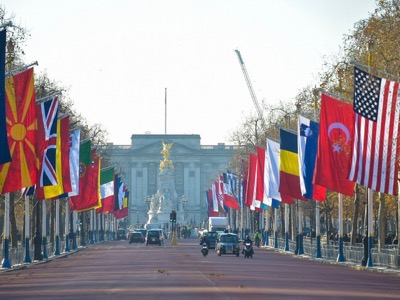Summitul lansează NATO în spațiu,
costuri până la stele
Manlio Dinucci
Are loc la Londra, pe 4 Decembrie, Consiliul Atlanticului de Nord, al Sefilor de Stat și de Guvern, care sărbătorește aniversarea a 70 de ani ai NATO, definit de Secretarul General, Jens Stoltenberg, “ca alianța cea mai reusita din Istorie”.
Un "succes" incontestabil. De la demolarea prin război, a Federației Iugoslave, în 1999, NATO s-a extins de la 16 la 29 de țări (30 daca includem acum Macedonia de Nord), extinzându-se spre Est, foarte aproape de Rusia. "Pentru prima dată în Istoria noastră - subliniază Stoltenberg - avem trupe gata de luptă în Estul Alianței noastre". Dar Organizația Tratatului Atlanticului de Nord a mers și mai departe, extinzându-și operațiunile de război de la Munții afgani și prin deșerturile africane și ale Orientului Mijlociu.
Acum Marea Alianță ambitionează și mai mult. La Summit-ul de la Londra - anunță, anticipat, Stoltenberg – conducatorii celor 29 de țări membre "vor recunoaște Spațiul ca al cincilea nostru cîmp de operatiuni", care se alătură pamîntului, mării, aerului și spațiului cibernetic. "Spațiul este esențial pentru succesul operațiunilor noastre", subliniaza Secretarul General, lasînd sa se înteleaga că NATO va dezvolta un program spațial militar. Evident, nu oferă detalii, dar informează că NATO a semnat primul contract de 1.000.000.000 de dolari pentru modernizarea celor 14 avioane AWACS, ale lui. Ele nu sunt simple avioane radar, dar centre de comandă zburătoare, produse de Boeing americana, pentru gestionarea bătăliei prin intermediul sistemelor spațiale.
Desigur, aproape niciunul dintre liderii europeni (pentru Italia, Prim-ministrul Conte) care, pe 4 Decembrie, "vor recunoaște Spațiul ca al cincilea nostru câmp de operațiuni", cunoaște programul spațial militar al NATO, pregătit de Pentagon și de comandourile superioare militare europene subordonate, împreună cu principalele industrii aerospațiale. Cu atât mai puțin stiu Parlamentele, ca cel italian, care acceptă orice decizie a NATO-ului, sub comanda SUA, fără sa se preocupe cu implicațiile lor politico-militare și economice.
NATO este lansata în Spațiu în continuarea noului Comandament spațial creat de Pentagon, în luna August, cu scopul, declarat de Președintele Trump, de "a garanta că domeniul american al Spațiului nu va fi niciodată amenințat". Trump apoi a anunțat, sțabilirea ulterioară a Forței Spațiale a Statelor Unite, cu sarcina de a "apăra interesele vitale americane în Spațiu, viitorul câmp de luptă al războiului". Rusia și China acuză SUA de a deschide calea pentru militarizarea Spațiului, avertizând că au capacitatea de a răspunde. Toate acestea maresc pericolul războiului nuclear.
Chiar dacă programul spațial militar al NATO nu este încă cunoscut, un lucru este sigur: va fi extrem de costisitor. La Summit, Trump va presiona aliații europeni pentru ca să-și mărească cheltuielile lor militare spre 2% sau mai mult, din PIB. Până în prezent, au făcut-o opt țări: Bulgaria (care a ridicat la 3,25%, ceva mai putin de 3,42%, al SUA), Grecia, Marea Britanie, Estonia, România, Lituania, Letonia și Polonia. Ceilalti, cu toate ca ramîn sub 2%, sunt angajati să le marească. Determinată de cheltuiala masiva a SUA - 730.000.000.000 de dolari în 2019, de 10 ori superioara celei a Rusiei - cheltuiala militara anuala a NATO, conform datelor oficiale, depășește 1.000.000.000.000. de dolari. De fapt, este superioara celei indicate de NATO, deoarece nu include diferite elemente de natură militară: de exemplu, cea a armelor nucleare ale SUA, înscrisa în buget, nu cel al Pentagonului, ci cel al Departamentuluiul de Energie.
Cheltuiala militara italiana, care a crescut de la 13º la locul 11º în lume, în termeni reali, se ridica la aproximativ 25.000.000.000 de euro pe an, mereu în creștere. În luna Iunie, guvernul Conte I, a adăugat 7.200.000.000 de euro, de asemenea oferite de Ministerul Dezvoltării Economice, pentru a achiziționa sisteme de armament. În Octombrie, în cadrul reuniunii sale cu Secretarul General al NATO, guvernul lui Conte II, a promis să o mărească în mod constant cu aproximativ 7.000.000.000 de euro pe na, începînd din 2020 (La Stampa, 11 Octombrie 2019).
La Summit-ul de la Londra, îi vor fi cerute Italiei mai multe miliarde din banii publici, pentru ca să finanțeze operațiunile militare ale NATO-ului în Spațiu, în timp ce nu există bani pentru a menține în siguranță și pentru a reconstrui viaductele care se prăbușesc.
Il manifesto, 3 Decembrie 2019
Traducere: Light Journalist
«DECLARATIA DE LA FLORENTA»
Manlio Dinucci
Geograf și geopolitolog. Cele mai recente cărți: Laboratorio di geografia, Zanichelli 2014; Diario di viaggio, Zanichelli 2017; L'arte della guerra / Annali della strategia USA / NATO 1990-2016, Zambon 2016, Guerra Nucleare. Il Giorno Prima 2017; Diario di guerra Asterios Editores 2018, Prémio Internacional de Análise Geostratégica acordat pe 7 iunie 2019 de Club de Periodistas de México, A.C.

.jpg)







/https://www.niagarafallsreview.ca/content/dam/thestar/news/canada/2021/09/25/huawei-executive-meng-wanzhou-receives-warm-welcome-upon-return-to-china/_1_meng_wanzhou_2.jpg)















